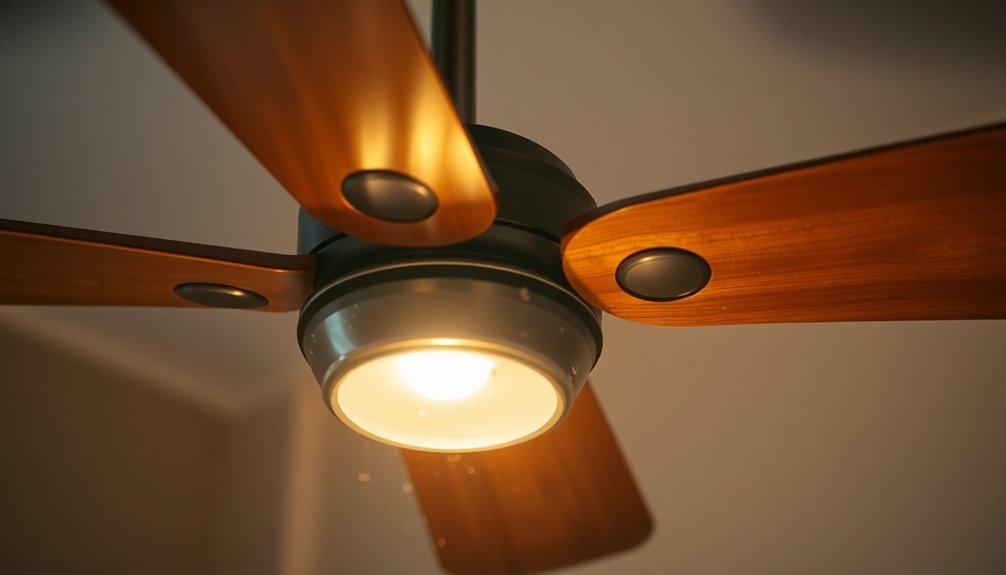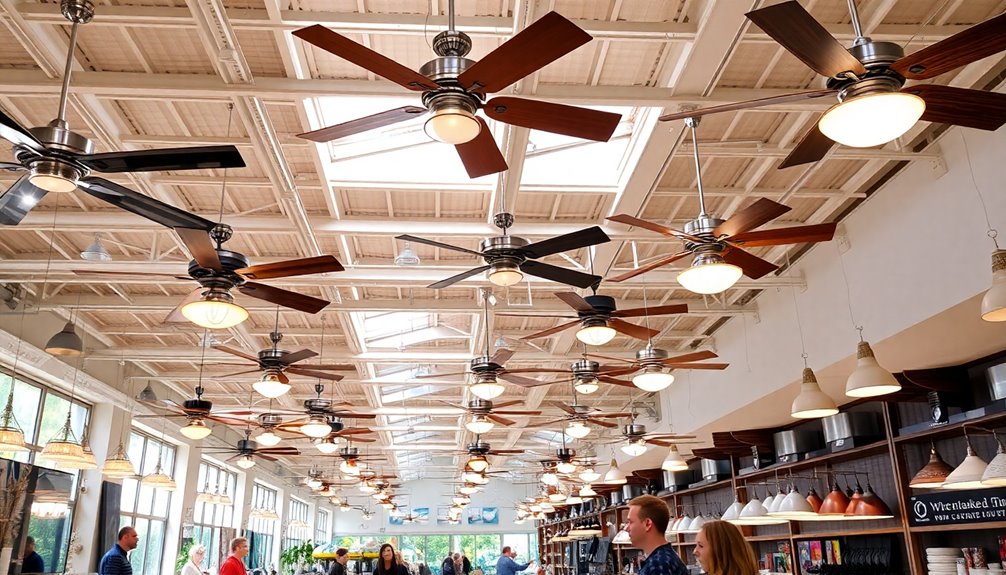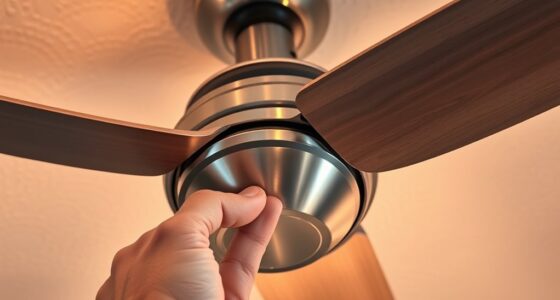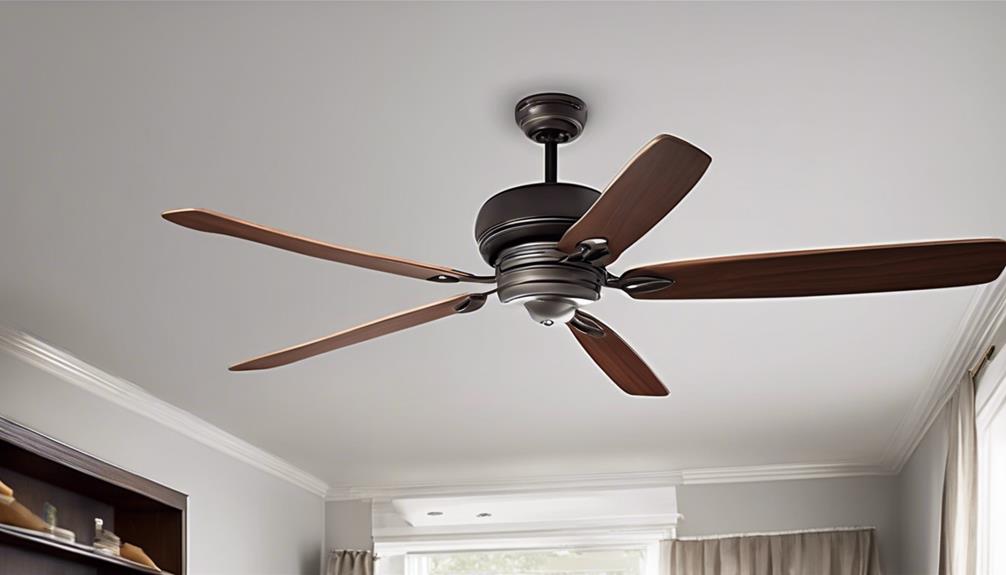If your ceiling fan wobbles, it usually means something's not quite right. Common culprits include loose screws, dust accumulation, and warped blades. Over time, dust can shift the balance and make your fan shake. You might also find that improper installation or blade misalignment plays a role. Start by checking that all screws are tight and blades are evenly spaced. If the wobbling continues, consider using a balancing kit to help even things out. There's plenty more to uncover about maintenance and fixes to guarantee your fan runs smoothly and quietly.
Key Takeaways
- Loose screws securing the blades can lead to instability and cause the fan to wobble.
- Dust accumulation on one side of the blades can disrupt balance and contribute to wobbling.
- Warped blades due to age or humidity can exacerbate wobbling issues in the fan.
- Improper installation, such as uneven blade spacing, may result in an unstable ceiling fan.
- Regular inspections and maintenance can help identify and prevent wobbling problems early.
Causes of Ceiling Fan Wobble

When you notice your ceiling fan wobbling, it's often due to a few common causes that can disrupt its balance. One major issue is loose screws. Over time, the hardware securing the blades can loosen, leading to a wobbly ceiling fan. Regular inspections can help you catch these loose screws before they cause significant problems.
Another factor is dust accumulation. If dust collects on one side of the blades, it can add extra weight, throwing off the fan's equilibrium. Make it a habit to clean your fan blades regularly to prevent this imbalance.
Warped blades can also be a culprit, especially if your fan is older or has been exposed to humidity and temperature changes. Warped blades can exacerbate any wobbling issues, making it essential to check for any signs of damage.
Lastly, improper installation might contribute to instability. If the blades aren't evenly spaced or if a non-fan rated ceiling box is used, the result can be excessive wobbling.
Fixing Blade Alignment

Regularly checking your ceiling fan's blade alignment can greatly reduce wobbling issues.
Start by ensuring that all fan blades are securely attached to their respective blade holders. If you notice any loose screws, tighten them to maintain stability.
Next, measure the distance between each blade and the ceiling using a yardstick or tape measure. This will help confirm even spacing, which is essential for balancing your fan.
Here's what to do to fix any misalignment:
- Check that all screws holding the blade holder to the fan flywheel are tight.
- If you find any blades misaligned, gently bend the blade holder back into position.
- Run the fan after making adjustments to see if the wobbling has improved.
Using a Balancing Kit

A ceiling fan balancing kit can be a game changer when it comes to eliminating wobble. This kit typically includes plastic clips and adhesive weights designed to help you identify and correct the wobbling ceiling issue by adjusting the weight distribution of your fan blades.
To get started, attach a plastic clip to the tip of one blade and run the fan. Observe any changes in the wobble to pinpoint which blade is causing the problem.
Once you identify the problematic blade, you can apply adhesive weights to its underside in various positions until you minimize or eliminate the wobble. After making these adjustments, it's crucial to test the fan at high speed to verify that the wobbling has been effectively corrected and that the fan operates smoothly.
Regularly using a blade balancing kit can help maintain your ceiling fan's stability, preventing future wobbling and extending its lifespan.
Maintenance and Care Tips

To keep your ceiling fan running smoothly and free from wobble, consistent maintenance is key. By taking a few simple steps, you can guarantee your fan operates efficiently and lasts longer. Here are some essential maintenance tips you should follow:
- Clean the fan blades regularly to prevent dust accumulation, which can lead to imbalance and wobbling.
- Inspect and tighten all screws and hardware periodically to assure the stability of the fan and its components.
- Check for signs of wear and tear on the blades and motor, as these issues can exacerbate wobbling if left unaddressed.
Additionally, consider using a ceiling fan balancing kit to adjust blade weight distribution when necessary.
Scheduling routine maintenance at least once a year is also critical. This proactive approach helps you identify potential problems early on, ultimately prolonging the lifespan of your ceiling fan.
Remember, regular maintenance not only keeps your fan blades in top shape but also contributes to a safer and more comfortable home environment.
When to Call a Professional

Even with diligent maintenance, some ceiling fans may still experience persistent wobbling that signals deeper issues.
If you've tried adjusting and balancing your fan but the wobbling continues, it's time to contemplate calling a professional. This persistent wobble could indicate that the fan blades are warped or damaged, and only an expert can accurately diagnose and replace them if necessary.
Pay attention if the wobbling is accompanied by unusual noises or vibrations. This could suggest a problem with the motor or mounting hardware, which definitely warrants expert intervention.
If you notice that your fan feels loose from the ceiling or shows signs of improper installation, a professional can guarantee it's securely mounted and compliant with safety standards.
For complex issues, such as electrical problems or those involving the ceiling box, it's essential to consult a certified electrician or handyman.
Attempting DIY repairs in these cases can lead to safety hazards. Trusting a professional for repair not only assures your fan operates smoothly but also keeps your home safe.
Don't hesitate to reach out when the situation calls for expert help.
Frequently Asked Questions
How Do I Stop My Ceiling Fan From Wobbling?
To stop your ceiling fan from wobbling, start by tightening all screws on the blades and mounting bracket.
Next, clean the blades to remove dust and guarantee even weight distribution.
If it still wobbles, use a ceiling fan balancing kit to adjust the weight of the blades.
Check for warped blades and replace any that are damaged.
Finally, confirm the fan is securely mounted to a ceiling box designed for fan support.
Will a Ceiling Fan Fall if It Wobbles?
A ceiling fan's gentle spin can transform a room, but a wobble can trigger concerns.
If your fan wobbles, it mightn't fall immediately, but it could loosen over time, increasing the risk of a dangerous drop.
Regular checks for tight screws and proper installation can help maintain safety.
Ignoring the wobble won't make it go away; addressing it promptly guarantees both your fan's longevity and your peace of mind.
How Do You Rebalance a Ceiling Fan?
To rebalance your ceiling fan, start by checking that all blades are securely attached and inspect for any warped ones.
Use a ceiling fan balancing kit to identify imbalances; attach the clip to the blades and test for wobbling.
Measure the distance between each blade and the ceiling for uniformity.
If wobbling continues, try switching two blades from opposite sides to redistribute weight evenly.
Don't forget to clean the blades regularly too!
How to Know if a Ceiling Fan Will Fall?
Did you know that nearly 10% of ceiling fan accidents result from improper installation?
To know if your ceiling fan might fall, look for signs like visible sagging, excessive wobbling, or unusual noises during operation.
Check if the mounting screws are tight and inspect the ceiling box for stability.
If you notice warped blades or rattling components, it's essential to address these issues immediately to guarantee your safety and prevent a potential disaster.
Conclusion
To sum up, you can tackle your ceiling fan's wobble by checking blade alignment, using a balancing kit, and performing regular maintenance. By ensuring the blades are level, balancing the weight, and keeping the fan clean, you'll create a smoother, quieter experience. When all else fails, don't hesitate to call a professional for help. Remember, a well-maintained fan not only looks good but also functions efficiently, providing you with comfort and peace of mind in your space.









